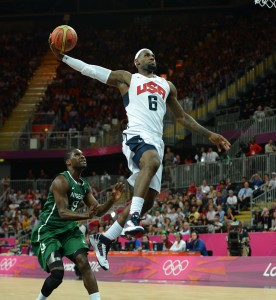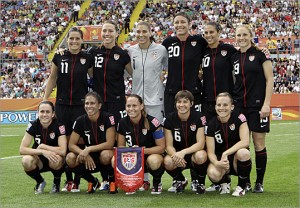Throughout the course of history, women have been fighting an uphill battle towards equality in just about every aspect of life. This is still true for the U.S. national soccer team. As of this writing, U.S. Soccer has 1.28 million Twitter followers. U.S. Women’s Soccer only has 279,000, a fraction of the popularity. While the number of followers for U.S. soccer may be slightly inflated due to the fact that it covers both the U.S. men’s national soccer team (USMNT) and the U.S. women’s national team (USWNT), the difference cannot be ignored.
Historically, the USWNT has been much more successful than the USMNT. This upcoming summer will mark the seventh-ever Women’s World Cup, one year after the playing of the twentieth playing of the Men’s World Cup. The USMNT has only qualified for the tournament and after a surprising semi-final appearance in the first-ever World Cup in 1930, the best the team has ever done since is a quarterfinal exit in 2002. The USWNT, however, have never finished worse than third in a World Cup and have won the tournament twice in its relatively young history. Why, then, does the men’s team still garner more attention?
There are a variety of opinions on the topic but none seem to find definitive reasoning. The most common argument is that men are simply more athletic than women. This gap in performance is measurable and perceptible, moreso in some sports than others. LeBron James, and frankly just about NBA basketball player, can throw down a windmill dunk with relative ease. The handful of women who are able to dunk a basketball lack the size and athleticism to do it as often, as easily, or as fancifully as the men of the highest level in the same sport. In sports like track and field and swimming, the fastest men post faster times than the fastest women. In soccer, however, it’s harder to notice the differences while watching. The men’s game and the women’s game are technically similar and no spectator is timing how fast a striker can cover the ground between midfield and the top of the eighteen-yard box. This doesn’t necessarily disprove that the difference in ability is the cause for the difference in attention, but it certainly leads one to pursue other potential culprits.
Anna Greenawalt blames television producers. In a study of the 2004 Olympic Games to try and measure the excitement of men’s events versus women’s events, there was a rather interesting find: “men’s coverage was presented as more visually ‘exciting’ than women’s – it used more shot types, camera angles, and motion special effects per minute. These differences may contribute to perceptions that women’s sports are inferior or ‘naturally’ less interesting than men’s, reinforcing men as the symbolic authority in sport” (Greer et al, 2009, p. 173). Greenawalt blames television producers, the ones who make these decisions about shot types and camera angles, for feeding into the cycle that women are less exciting to watch than men (Greenawalt).
Graham Hays, a writer for ESPNW, an ESPN.com subsidiary that focuses on women’s sports and women in sports, lists a variety of potential reasons. Some of these include the fact that betting on women’s sports isn’t as popular, or that men only need to be talented to be admired whereas women need to be talented and attractive, or that sports is one of the last boys’ clubs that men are desperately keeping to themselves (Hays).
One particular argument of his says that men don’t have a connection to the game because they don’t know the players (Hays). Fandom develops over time and full-fledged fanaticism takes an inconceivable amount of hours of reading, watching and analyzing not to mention commiserating and celebrating over the course of many years. And there just simply isn’t enough coverage or literature for men to have a serious connection to the sport. This vicious cycle is explained in another article under the sexism in the media umbrella.
Every World Cup year, Americans seem to suddenly care about soccer and once it’s over, it fades back into oblivion. Right now we’re in between a men’s World Cup and a Women’s World Cup so the women’s team is at a significant advantage when it comes to looking at their numerical popularity because all of the people who watched last year started following the men on Twitter but the women haven’t had a chance to win over the hearts of viewers yet. This article will be an interesting one to re-examine in several months once the Women’s World Cup has been played and all of the viewers have seen just how capable these female athletes are.
Works Cited
Greenawalt, Anne. “Anne Greenawalt: Are Men’s Sports “Naturally” More Exciting Than Women’s Sports?” Anne Greenawalt. N.p., 10 Dec. 2010. Web. 25 Apr. 2015.
Greer, J., Hardin, M. & Homan, C. (2009). “‘Naturally’ less exciting? Visual production of men’s and women’s track and field coverage during the 2004 Olympics.” Journal of Broadcasting & Electronic Media, 53(2), p. 173-189.
Hays, Graham. “Why Men Don’t Watch Women’s Sports.” Page 2. ESPN, 8 Mar. 2003. Web. 25 Apr. 2015.
References
http://www.fifa.com/associations/association=usa/
http://www.fifa.com/tournaments/archive/worldcup/index.html
Written by: Jake Toffler




Pingback: USWNT's Star Power Gives Huge Edge Over Bruce Arena's Men
Pingback: The place’s the Media Buzz for the Ladies’s World Cup? | Posts
Pingback: Where’s the Media Buzz for the Women’s World Cup? : The Buzz Bin